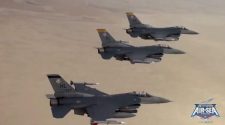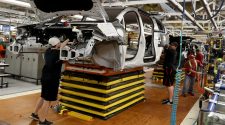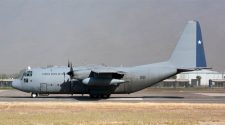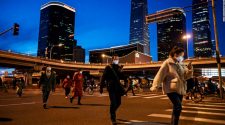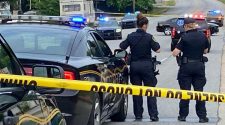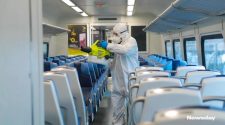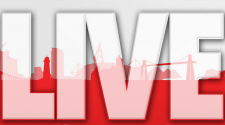Satellite photos show what appear to be armoured personnel carriers and other vehicles belonging to the China’s paramilitary People’s Armed Police parked in a sports stadium in the city of Shenzhen, which borders Hong Kong, which some have interpreted as Beijing threatening increased force against pro-democracy protesters.
The pictures collected on Monday by Maxar’s WorldView show 500 or more vehicles sitting on and around the soccer stadium at the Shenzhen Bay sports centre just across the harbour from the Asian financial hub that has been rocked by more than two months of near-daily street demonstrations.
Flights at Hong Kong’s airport, one of the world’s busiest, were disrupted on Monday and Tuesday by a mass demonstration and occasional violence inside its terminal.
Why are people protesting?
The protests were triggered by a controversial bill that would have allowed extraditions to mainland China, where the Communist party controls the courts, but have since evolved into a broader pro-democracy movement.
Public anger – fuelled by the aggressive tactics used by the police against demonstrators – has collided with years of frustration over worsening inequality and the cost of living in one of the world’s most expensive, densely populated cities.
The protest movement was given fresh impetus on 21 July when gangs of men attacked protesters and commuters at a mass transit station – while authorities seemingly did little to intervene.
Underlying the movement is a push for full democracy in the city, whose leader is chosen by a committee dominated by a pro-Beijing establishment rather than by direct elections.
Protesters have vowed to keep their movement going until their core demands are met, such as the resignation of the city’s leader, Carrie Lam, an independent inquiry into police tactics, an amnesty for those arrested and a permanent withdrawal of the bill.
Why were people so angry about the extradition bill?
Beijing’s influence over Hong Kong has grown in recent years, as activists have been jailed and pro-democracy lawmakers disqualified from running or holding office. Independent booksellers have disappeared from the city, before reappearing in mainland China facing charges.
Under the terms of the agreement by which the former British colony was returned to Chinese control in 1997, the semi-autonomous region was meant to maintain a “high degree of autonomy” through an independent judiciary, a free press and an open market economy, a framework known as “one country, two systems”.
The extradition bill was seen as an attempt to undermine this and to give Beijing the ability to try pro-democracy activists under the judicial system of the mainland.
How have the authorities responded?
Lam has shown no sign of backing down beyond agreeing to suspend the extradition bill, while Beijing has issued increasingly shrill condemnations but has left it to the city’s semi-autonomous government to deal with the situation. Meanwhile police have violently clashed directly with protesters, repeatedly firing teargas and rubber bullets.
Beijing has ramped up its accusations that foreign countries are “fanning the fire” of unrest in the city. China’s top diplomat Yang Jiechi has ordered the US to “immediately stop interfering in Hong Kong affairs in any form”.
Lily Kuo and Verna Yu in Hong Kong
Chinese state media have said only that the Shenzhen exercises had been planned beforehand and were not directly related to the unrest in Hong Kong, although they came shortly after the central government in Beijing said the protests were beginning to show the “sprouts of terrorism”.
President Donald Trump tweeted that US intelligence believes that the Chinese government is moving troops to its border with Hong Kong and that, “Everyone should be calm and safe!”
Beijing has been apparently reluctant to send in police or army units from the mainland or to mobilise the People’s Liberation Army garrison in Hong Kong to quell the unrest. It’s seen as mindful of the devastating effect that would have both on the territory’s reputation as a safe and stable place to invest in, and as indication of the Communist party’s failure to win over the hearts and minds of the city’s 7.3 million residents, 22 years after the former British colony was handed over to China.
It would also be a shocking reminder of the PLA’s bloody crackdown on pro-democracy demonstrations centred on Beijing’s Tiananmen Square 30 years ago, which remains a taboo subject in China but is memorialised with a massive rally and march each year in Hong Kong.
Mainland China is believed to have already dispatched officers to fortify the ranks of the Hong Kong police, and may also have planted decoys among the protesters in order to encourage more violent acts that could eventually turn ordinary Hong Kongers against the protest movement.
Such a change in sentiments does not yet appear to have happened despite rising violence surrounding protests and the shutdown of the city’s usually bustling international airport for two days after it was occupied by demonstrators.




